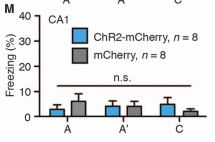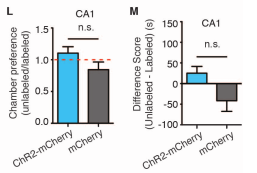Rylan Schaeffer

Resume
Research
Learning
Blog
Teaching
Jokes
Kernel Papers
Creating a False Memory in the Hippocampus
by Ramirez and Liu, ..., Tonegawa (Science 2013)
Background
Previously, ablating/inactivating memory engram neurons prevented retrieval of fear response
Previous work by the Tonegawa lab showed that optogenetically activating memory engram cells (specifically in dentate gyrus (DG) during contextual fear conditioning) would reactive the fear memory.
Research Questions
- Is creating a false memory (i.e. fear association) with optogenetic interventions possible? Yes
Experiments
Exp 1 (Cellular)
- Tag hipppocampal (dentate gyrus) cells
Exp 2 (Behavioral)
The mouse is placed on DOX, then DOX is removed and the mouse is allowed to explore neutral context A. Later, in Context B, mouse is shocked while neurons tagged in context A are optogenetically activated. The mouse is then placed back in Context A and subsequently Context C.

- Experimental group (ChR2-mCherry) freezes in context A’ (i.e. the second time being placed in Context A)

- Control group (mCherry) does not freeze in contexts A, A’ or C
- Takeaway: Optogenetic stimulation during shocks in context B cause context A to gain negative association
- Repeating, but replacing injections in dentate gyrus with injections in CA1 resulted in no effect

Exp 3 (Behavioral)
- To test for whether presence of ChR2-mCherry was the cause of the previous effects, repeat without the light stimulation (ChR2-mCherry, No light)
- No freezing during A, C, C’ or A’ except for group exposed to light during B

- Takeaway: acquired fear response to context A cannot be explained by presence of ChR2-mCherry
- Repeating, but replacing injections in dentate gyrus with injections in CA1 resulted in no effect

Exp 4 (Behavioral)
- Does fake fear memory interfere with genuine fear memory of Context B that should exist?
- Repeat Experiment 2, but now testing fear recall in Context B
- For group with optogenetic intervention, low freezing in context B without light and more freezing in context B with light
- For group without optogenetic intervention, high freezing in Context B without light and less freezing in context B with light

- Authors explain as competitive conditioning: contexts A and B compete to explain the shock
Exp 5 (Neural)
- Test the role of Basolateral Amygdala (BLA) and Central Amygdala (CeA)
- Three groups of mice underwent previous experiment and were killed after testing in B’ (natural recall), A’ (false recall) or C’ (neutral context)
- Significantly more cells in BLA and CeA were active during Natural Recall and Fear Recall than the neutral context

- Takeaway: conditioning recruits BLA and CeA neurons
Exp 6 (Neural, Behavioral)
- Using Context B for shocking and testing context B allows for possibility of competitive conditioning
- Retest freezing, in a totally new Context D
- For group without optogenetic intervention, no difference in freezing
- For group with optogenetic intervention, light induced more freezing

Exp 7 (Neural, Behavioral)
- Does creation of false fear memory cause different behavior in freely exploring mice?
- Tag either left side of the room or right side of the room, then shock mouse in different context while optogenetically stimulating the labeled cells
- mCherry = no optogenetic intervention, ChR2-mCherry = optogenetic intervention

- Mice with optogenetic intervention spend less time on tagged side (Fig 4B, Fig 4LM)

